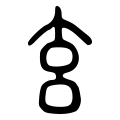| 玄 | ||
|---|---|---|
| ||
| 玄 (U+7384) "dark, profound" | ||
| Pronunciations | ||
| Pinyin: | xuán | |
| Bopomofo: | ㄒㄩㄢˊ | |
| Wade–Giles: | hsüan2 | |
| Cantonese Yale: | yùhn | |
| Jyutping: | jyun4 | |
| Japanese Kana: | ケン ken / ゲン gen (on'yomi) くろい kuroi (kun'yomi) | |
| Sino-Korean: | 현 hyeon | |
| Names | ||
| Japanese name(s): | 玄/げん gen | |
| Hangul: | 검을 geomeul | |
| Stroke order animation | ||
 | ||
Radical 95 or radical profound (玄部) meaning "dark" or "profound" is one of the 23 Kangxi radicals (214 radicals in total) composed of 5 strokes.
In the Kangxi Dictionary, there are only six characters (out of 49,030) to be found under this radical. In addition, the final dot stroke of the character in the Kangxi Dictionary was omitted (𤣥) to avoid using the same character in Kangxi Emperor's name 玄燁 (see naming taboo).
This radical is not used in Simplified Chinese dictionaries.
YouTube Encyclopedic
-
1/5Views:121 1076 407289 8323 8729 195
-
Chrono Cross - Fields of Time ~Home World~ (3 Projects Arranged)
-
Classic VGM 95: Zelda: Twilight Princess - Hyrule Field
-
~⌘ Temple of the Moon ⌘~ performed by Erutan ( katethegreat19 )
-
The Dreamer (Reckless Logic)
-
Classic VGM 160: Donkey Kong Country 2 - Stickerbrush Symphony
Transcription
Evolution
-
Bronze script character
-
Large seal script character
-
Small seal script character
Derived characters
| Strokes | Characters |
|---|---|
| +0 | 玄 ("dark, deep, profound, abstruse") |
| +4 | 玅 (=妙 -> 女, "mysterious, subtle, exquisite") |
| +5 | 玆 ("now, here; this; time, year") |
| +6 | 率 ("to lead; ratio; rate, frequency; limit") 玈 ("black") |
Variant forms
There is a design nuance in different printing typefaces for this radical character, akin to the differences found in radical 亠 and 幺. Traditionally, the first stroke is a vertical dot in printing typefaces, and the two turning strokes are broken into two respectively to adapt to the carving of movable type systems, and usually there is a gap between the third and the fourth strokes. Currently, in both Simplified Chinese and Traditional Chinese, the first stroke becomes a slant dot, and the discontinuous turning strokes are merged into one to imitate its handwriting form, though the traditional printing form is still widely used in Traditional Chinese publication. The traditional form remains standard in modern Japanese and Korean printing typefaces.
The difference of the upper part 亠 applies to both printing typefaces and handwriting forms; The difference of the lower part 幺 exists only in printing typefaces, not in any handwriting form.
| Traditional Typefaces | Handwriting form Modern Chinese |
|---|---|
| 玄 | 玄 |
Sinogram
As an independent sinogram it is a Jōyō kanji, or a kanji used in writing the Japanese language.[1] It is a secondary school kanji.[2] It refers to the color of the night sky.
See also
References
- ^ "Jōyō Kanji Hyō" 常用漢字表 [List of Joyo Kanji] (PDF) (in Japanese). Agency of Cultural Affairs, Government of Japan. Retrieved November 7, 2018.
- ^ "KANJI-Link". www.kanji-link.com. Retrieved 2023-06-02.
Further reading
- Fazzioli, Edoardo (1987). Chinese calligraphy : from pictograph to ideogram : the history of 214 essential Chinese/Japanese characters. calligraphy by Rebecca Hon Ko. New York: Abbeville Press. ISBN 0-89659-774-1.
- Lunde, Ken (Jan 5, 2009). "Appendix J: Japanese Character Sets" (PDF). CJKV Information Processing: Chinese, Japanese, Korean & Vietnamese Computing (Second ed.). Sebastopol, Calif.: O'Reilly Media. ISBN 978-0-596-51447-1.



